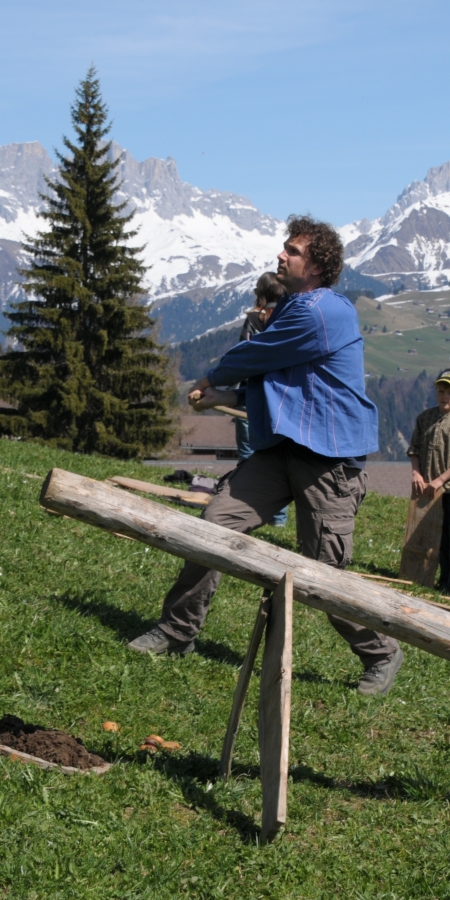Folk game from ancient times.
Hürna in Furna

The catchers
Ideally, the pitch should have a slope of between 18 and 25 per cent. The hurdle bar is set up at the lowest point, with the direction of impact against the slope. The 10-metre-wide catching field begins about 20 metres above the batten. The field is open at the top. The lowest post in the field is called "Gitzi", the player standing there "Gitzler". The selection of the groups is left to the two youngest participants. A shingle is marked on one side with "Gudlä" (damp earth). Before the shingle is thrown up, the voters agree on which side is dry or dirty. After the selection, the catchers move to the target field. Their task is to intercept as many "huri" as possible that are thrown into the field. To do this, the roof shingle (about 60 cm long, 25 to 30 cm wide and 1.5 cm thick) is thrown into the air in circular movements, or "geschlingget" in Hürnerspeak. The "Huri" is only "Erblaktet", i.e. intercepted with the hand, if it flies directly towards the catcher.
The batsmen
The task of the batsmen is to hit the "Huri" as often as possible into the target field with the help of the "Huristecken" (a baton cut from a hazel tree in winter, 2 m long and 3 - 4 cm thick) without it being intercepted. The first batsman is allowed to hit until his "huri" is intercepted or he hits three "bucks" in a row. The first batting party cuts a notch in a thin log for each "good". When the catchers become batsmen, they see how many "good" the other group has hit. Now the batting group can cut out a notch on each "good". As soon as all the notches have been cut away, this is called "fought back". The score is a draw. However, if the party brings in another "good" before all the beaters have had their turn, they have won. This party starts the new round, "uf z'Nüüä"!
The Huri
The "Huri" has a great resemblance to an ice hockey puck. The disc has a diameter of 5-6 cm. It is turned from hardwood (beech, cherry, walnut). The most suitable is an overgrown, crippled piece of wood, a "Mäscher". The "Huri" is mounted on the batten with "Dräck".
Text/picture: Heidi Wyss, Furna
Origin
There is speculation about the origin of the "Hurnä". According to an old Walser newspaper, it is assumed that the "Hürna" was brought to Rhaetia by the Walsers in the 13th century. In the Walser settlements of Graubünden, the game apparently only took root in Furna. The oldest contemporary witness came from the 17th or 18th century.
Summary Hürna
Here you will find a summary prepared by Lukas Sonderegger in 2003, which was revised by Johannes Bärtsch in 2014. Enjoy reading!